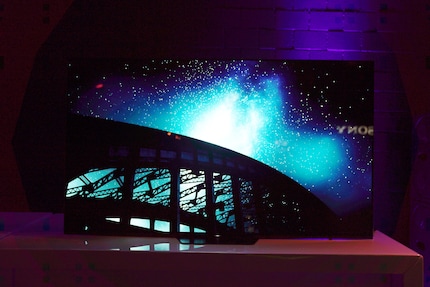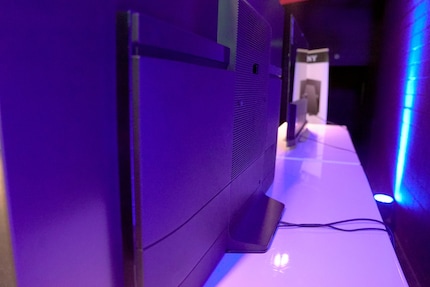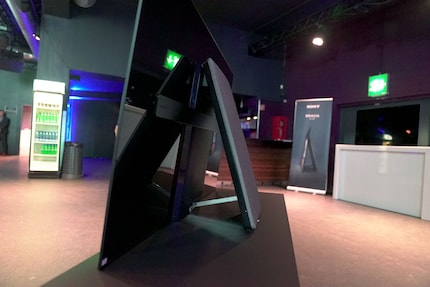Getting hands on with the Sony OLED AF8 – it’s almost here
We’re in complex 457 in Altstetten, Zurich, where Sony is presenting its 2018 product highlights. The focus is on the new OLED TV, and I have to hand it to them, the name has a certain ring to it. Read on to find out the benefits of the AF8, their latest model.
Sony is releasing a new OLED TV. That is newsworthy in itself, as it’s another sign the OLED market is fast booming. Every day, the cult gains new fans, and experts in the television industry agree that OLED will dominate the market sooner or later. The thing that puts people off is the amount you have to fork out for this kind of advanced technology. That’s why any development is eyed with suspicion.
The story won’t be any different with the AF8.
The Sony product preview for 2018 in Altstetten is a chance for us to get a peek at these trendy tech gems before they’re available in the shops. I can tell you this already: the TV is blooming amazing – can you tell I’m excited? It’s expected to go on sale from April. And you can preorder from (roughly) the end of February – basically, as soon as we’re told the prices.
The thing about OLEDs and the «true» black
The Sony AF8 is an OLED TV, which stands for organic light-emitting diode. It sounds a bit cryptic, but it just means self-lit LED. That still might not mean anything to you, so let me explain.
In OLED TVs, the light emitting diodes (LEDs) – in other words, the pixels – aren’t illuminated by a LED wall behind it. Instead, they light up themselves. Similarly, the pixels can switch themselves off whenever black needs to be displayed on the screen. It’s almost like a switch. This marks a new direction for LCD televisions. Previous models could never have done that, as LEDs were always on. You’d get a grey haze where black should have been.

But why am I harping on about this black level?
Well, for one thing, you can spot the difference between true black and the greyish-black as soon as you put an OLED and LCD TV side by side.
Moreover, the depth of the black level allows for incredibly good contrast values. This makes the difference between the darkest and lightest pixel pretty decisive. The greater this difference, the greater the colour space for depicting colour. The contrast value also plays an important role in HDR:
So you see, everything is somehow connected. And it all started with the black level.
As a quick side note: in case you were wondering, the AF8 features Dolby Vision.
A small processor goes big
The best panel in the world is no use if the processor doesn’t bring any benefits to image editing. The good news is Sony has included the X1 Extreme processor in all its premium TVs, and the AF8 is no exception. Sony is proud of the little board that punches above its weight.
It has a certain knack for suppressing image noise – in other words, the bits that you’d call «that grainy mess on the picture». The X1 Extreme also features upscaling from full HD content to 4K like no other.

These are two features that come into play in live TV in particular. If you don’t already have one of those 4K blu-rays with undeniably good source material stashed away then you’re reliant on a strong processor that can get the most out of the signal. Or one that can even boost the signal slightly.
As a general rule, OLED pixels have very low reaction times. That’s why it’s no surprise you hardly get any motion blur on the AF8. At least not on the footage they showed. Of course, I’d have liked to take a closer look, especially with the gamers out there in mind.
Sound through vibration
There are four exciters behind the panel that provide the sound. They don’t move air; they move the image itself. If you put your hand on the TV, you would feel a slight vibration. But don’t worry. There’s no chance of it juddering across the table and onto the floor.
Acoustic Surface in Sony’s promotional video
The whole thing is called Acoustic Surface technology and, my goodness, it works. When we were shown a concert recording, it was clear that the TV produces dynamic and powerful sound. The bass built into the back of the panel hummed gently. Thanks to the four exciters, the source of the sound can be localised surprisingly well. For instance, should a plane woosh into the top left of the screen, you’ll hear its clamouring engines in the top left first of all. It’s unbelievable.
At present, I can’t comment on how good the sound quality is compared with a mid-range soundbar. I’d need more time and my own source material – neither of which were possible at the hands-on event. There’s always next time.
Seem familiar?
You might feel like you’ve heard all of this before. I agree that purely from a features perspective, the AF8 is almost identical to its predecessor. I know because I tested it last December.
But the main difference lies in the design. The A1 stands on legs like a picture frame you can’t hang on the wall.
However, the panel is slightly angled, and not everyone likes that. The area of the screen that is at eye level is slightly slanting, which takes some getting used to. The AF8 brings back traditional features with the support leg, and as such, is Sony’s alternative for people who struggled with the previous more unusual design. The image is vertical again and back to being perpendicular to its viewers.


The new support leg is so thin that you hardly notice it under the panel. As before, the aluminium frame is plain and simple. Sony calls this soft minimalism. Righto. I just like it because the design doesn’t take away from the image.
Verdict
Yes, OLEDs are great, and after checking out the Sony OLED, I haven’t had a change of heart. Once you’ve gazed into the jet black of an OLED panel, there’s no going back. What is more divisive is the fact the AF8 uses the same processor and sound technology as its predecessor.
On the one hand, this can be a good thing because the previous model kept coming out on top in industry tests. But at the same time, it could be seen as a negative as it means there are hardly any updates to the equipment. Except for the design.
As far as the latter is concerned, it was obviously established with mass taste in mind. I do think that’s a shame. In fact, I’m drawn to the A1 because it went the opposite way and made some bold decisions. But don’t get me wrong, I’m still gobsmacked when I see the AF8’s amazing contrast and natural colours.
And the Acoustic Surface technology is the icing on the cake. Thanks to the sound-emitting images, you can put off buying that soundbar. Which is great, because it means more money in your pocket.
I write about technology as if it were cinema, and about films as if they were real life. Between bits and blockbusters, I’m after stories that move people, not just generate clicks. And yes – sometimes I listen to film scores louder than I probably should.
From the latest iPhone to the return of 80s fashion. The editorial team will help you make sense of it all.
Show all